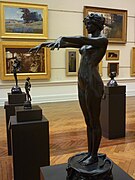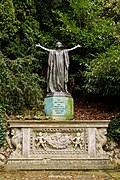
Sir William Hamo Thornycroft was an English sculptor, responsible for some of London's best-known statues, including the statue of Oliver Cromwell outside the Palace of Westminster. He was a keen student of classical sculpture and was one of the youngest artists to be elected to the Royal Academy, in 1882, the same year the bronze cast of Teucer was purchased for the British nation under the auspices of the Chantrey Bequest.
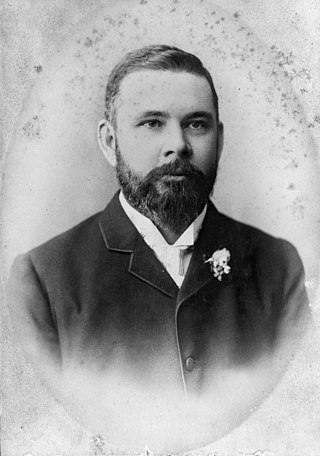
Thomas Joseph Byrnes was an Australian politician and barrister. He was Premier of Queensland from April 1898 until his death in September of the same year, having previously served in several ministerial positions in his parliamentary career. He was the first Roman Catholic Premier of Queensland and the first to die in office.

The Queen Victoria Gardens are Melbourne's memorial to Queen Victoria. Located on 4.8 hectares opposite the Victorian Arts Centre and National Gallery of Victoria, bounded by St Kilda Road, Alexandra Avenue and Linlithgow Avenue.
Events from the year 1923 in art.
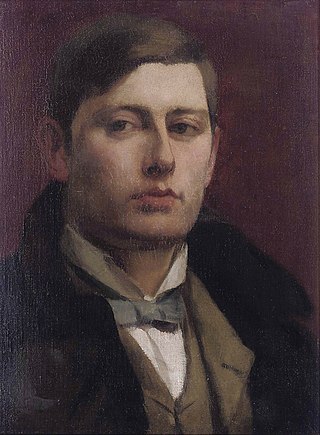
Sir George James Frampton, was a British sculptor. He was a leading member of the New Sculpture movement in his early career when he created sculptures with elements of Art Nouveau and Symbolism, often combining various materials such as marble and bronze in a single piece. While his later works were more traditional in style, Frampton had a prolific career in which he created many notable public monuments, including several statues of Queen Victoria and later, after World War I, a number of war memorials. These included the Edith Cavell Memorial in London, which, along with the Peter Pan statue in Kensington Gardens are possibly Frampton's best known works.

Sir Edgar Bertram Mackennal, usually known as Bertram Mackennal, was an Australian sculptor and medallist, most famous for designing the coinage and stamps bearing the likeness of George V. He signed his work "BM".
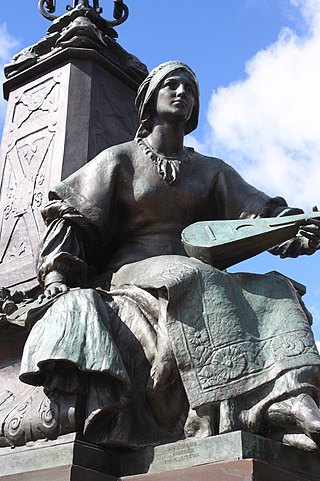
Paul Raphael Montford was an English-born sculptor, also active in Australia; winner of the gold medal of the Royal Society of British Sculptors in 1934.

The Sydney Cenotaph is a heritage-listed monument located in Martin Place, in Sydney, New South Wales, Australia. It was designed by Bertram Mackennal and built from 1927 to 1929 by Dorman Long & Co. It is also known as Martin Place Memorial and The Cenotaph. It is one of the oldest World War I monuments in central Sydney. It was added to the New South Wales State Heritage Register on 11 November 2009.

King Edward VII of the United Kingdom has been depicted a number of times in different media and popular culture.
Edward Alfred Briscoe Drury was a British architectural sculptor and artist active in the New Sculpture movement. During a long career Drury created a great number of decorative figures such as busts and statuettes plus larger monuments, war memorials, statues of royalty and architectural pieces. During the opening years of the 20th-century he was among the foremost architectural sculptors active in Britain and in that period created the series of works in central London for which he is perhaps now best known. These include the figures on the Old War Office building in Whitehall, elements of the facade of the Victoria and Albert Museum and four of the colossal statues on Vauxhall Bridge.

The Jubilee 150 Walkway, also variously known as the Jubilee 150 Commemorative Walk, the Jubilee 150 Walk, Jubilee 150 Plaques, the Jubilee Walk, or simply J150, is a series of (initially) 150 bronze plaques set into the pavement of North Terrace, Adelaide, South Australia from King William Street to Pulteney Street.

The Victoria Memorial is a large marble monument on the Maidan in Central Kolkata, having its entrance on the Queen's Way. It was built between 1906 and 1921 by the Government of India. It is dedicated to the memory of Queen Victoria, the Empress of India from 1876 to 1901.

The Machine Gun Corps Memorial, also known as The Boy David, is a memorial to the casualties of the Machine Gun Corps in the First World War. It is located on the north side of the traffic island at Hyde Park Corner in London, near the Wellington Arch, an Equestrian statue of the Duke of Wellington, the Royal Artillery Memorial, the New Zealand War Memorial, and the Australian War Memorial.
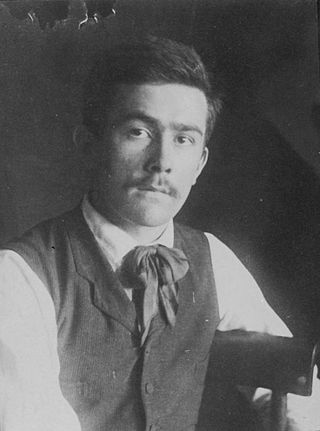
Samuel Aloysius Murray was an American sculptor, educator, and protégé of the painter Thomas Eakins.

Zealandia is a national personification of New Zealand. In her stereotypical form, Zealandia appears as an evidently Western European woman who is similar in dress and appearance to Britannia. Britannia is said to be the mother of Zealandia.

William Leslie Bowles, commonly referred to as Leslie Bowles or W. Leslie Bowles, was an Australian sculptor and medallist.

The Parliamentary War Memorial, also known as the Recording Angel Memorial, is a stone sculpture in Westminster Hall, unveiled in 1922, which commemorates the members of both Houses of Parliament of the United Kingdom who died in the First World War. It names 22 members of the House of Commons, 20 members of the House of Lords, and 9 senior members of staff, together with another 94 sons of members and officers of the House of Commons, who lost their lives in the war. Above the memorial is a large stained glass window which commemorates members and staff of both Houses who died in the Second World War.
John Neville Manners played cricket for Eton College in Fowler's match in 1910, and died in the early weeks of the First World War on the retreat from Mons. Poem LIV of The Muse in Arms by William Grenfell is addressed to him and entitled "To John".

The Offerings of Peace and The Offerings of War are a pair of bronze allegorical equestrian statues by Gilbert Bayes commissioned for the entrance of the Art Gallery of New South Wales. They have been on permanent display since their installation in 1926.

The Thames Ditton Foundry was a foundry in Thames Ditton, Surrey, which operated from 1874 to 1939 and which under various owners produced numerous major statues and monuments as one of the United Kingdom's leading firms of bronze founders.
